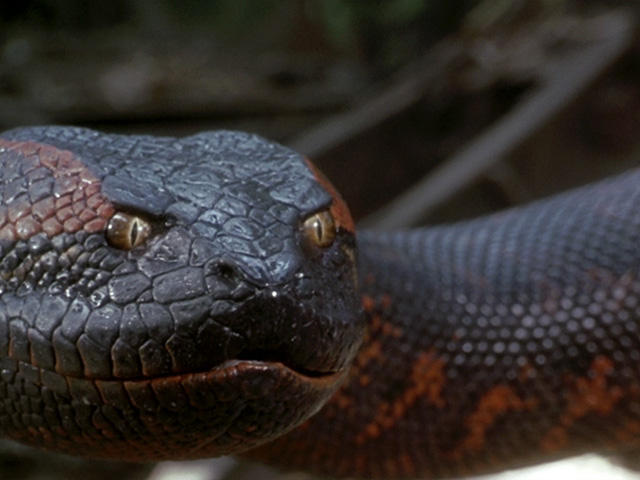It’s a scream! Museum’s Final Friday features “Anaconda” plus live boas, September 30
For immediate release ‐ September 28, 2016
Contact: Jon Pishney, 919.707.8083. Images available upon request

RALEIGH — Giant snakes have crawled their way into every realm of popular culture. Nicki Minaj sings about them, Neville Longbottom fought one, and we all know how Samuel L. Jackson feels about them when they get on his airplane. But what do we know about real giant snakes? For this month’s Final Friday, the North Carolina Museum of Natural Sciences will be showing “Anaconda” and crushing some conspiracy theories about giant snakes. How big do they get? Do they have any enemies? Can they really eat people? Find out at Final Friday, September 30, 6-9 p.m.
This 1997 film follows filmmaker Terri Flores (Jennifer Lopez) as she travels deep in the Amazon jungle looking for a forgotten tribe. Terri and her crew, which includes an anthropologist (Eric Stoltz) and a cameraman (Ice Cube), come across Paul (Jon Voight), who is stranded on the riverbank. He offers to help them find the tribe, but his secretive behavior puts everyone on edge. They realize too late that he’s using them to find a legendary anaconda that’s worth a fortune — if they can catch it. “Anaconda” begins at 7 p.m. and is rated PG-13. It is also listed among the 100 Most Enjoyably Bad Movies Ever Made in Golden Raspberry Award founder John Wilson’s book “The Official Razzie Movie Guide.”
Nearly Impossible Trivia Note: The “voice” of the giant anaconda is provided by Hollywood “voice god” Frank Welker, who also voiced Megatron on “The Transformers” animated TV series in the mid-1980s as well as “Scooby-Doo’s” Freddy Jones countless times over the past SIX decades.
Additionally, Museum staff and NC Herpetological Society members will be on hand (5:30-7 p.m.) to show off several live snakes, including a 7-foot-long boa constrictor, Brazilian rainbow boa, rosy boa and ball python, plus an assortment of smaller but no less hypnotizing constrictors ranging from a black rat snake to a brown water snake. And just prior to the movie, enjoy a short presentation by Bob Flook, the Museum’s Chief of Living Collections (live animals).
Final Fridays will take place on the last Friday of each month. A/V Geeks’ Skip Elsheimer returns to provide a fun night of trivia and tongue-in-cheek commentary on not-so-mainstream movies as well as samples from his vault of 24,000 films. Movies will be complemented by experts and hands-on science stations related to each night’s theme. Dinner (such as sliders or tacos), drinks (including NC beer and wine) and popcorn will be available to buy before the show. Doors open at 5:30 p.m., movies and presentations begin at 7 p.m. Admission: $5/person. For more information, a list of future Final Fridays, or to buy tickets, visit naturalsciences.org/finalfridays.
The North Carolina Museum of Natural Sciences (11 W. Jones St. and 121 W. Jones St.) in downtown Raleigh is an active research institution that engages visitors of every age and stage of learning in the wonders of science and the natural world, drawing them into the intriguing fields of study that are critical to the future of North Carolina. Hours: Mon.- Sat., 9 a.m.-5 p.m., and Sun., noon-5 p.m. Visit the Museum online at www.naturalsciences.org. Emlyn Koster, PhD, Museum Director; Susan Kluttz, Secretary, N.C. Department of Natural and Cultural Resources; Pat McCrory, Governor.
The N.C. Department of Natural and Cultural Resources (NCDNCR) is the state agency with a vision to be the leader in using the state’s natural and cultural resources to build the social, cultural, educational and economic future of North Carolina. Led by Secretary Susan Kluttz, NCDNCR’s mission is to improve the quality of life in our state by creating opportunities to experience excellence in the arts, history, libraries and nature in North Carolina by stimulating learning, inspiring creativity, preserving the state’s history, conserving the state’s natural heritage, encouraging recreation and cultural tourism, and promoting economic development. NCDNCR includes 27 historic sites, seven history museums, two art museums, two science museums, three aquariums and Jennette’s Pier, 39 state parks and recreation areas, the N.C. Zoo, the nation’s first state-supported Symphony Orchestra, the State Library, the State Archives, the N.C. Arts Council, State Preservation Office and the Office of State Archaeology, along with the Division of Land and Water Stewardship. For more information, please call (919) 807-7300 or visit www.ncdcr.gov.

